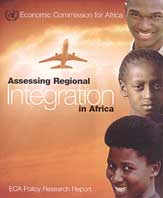Mixed results for regional economic blocs
Mixed results for regional economic blocs
Since 1994, when Africa began implementing a treaty to establish a continent-wide economic community, integration has proceeded weakly and irregularly across countries, sectors and regional economic communities. In its first comprehensive assessment of regional integration in Africa, the UN Economic Commission for Africa (ECA), based in Addis-Ababa, reports that the best performing regional economic communities had well-developed integration programmes that were implemented "steadily and effectively by member states." By contrast those communities affected by political, economic and social upheavals performed poorly, notes the study,Assessing Regional Integration in Africa 2004*, released in July.
There are 14 major regional economic groupings in Africa, considered the building blocks of the African Economic Community, which is expected to gradually develop over the next few decades under the terms of the 1994 Abuja Treaty. The goals of that treaty have been reinforced by the adoption in 2001 of the New Partnership for Africa's Development (NEPAD) and the establishment the following year of the African Union, a continental political organization.

The ECA reports that integration among African countries improved by an average of 4.5 per cent annually from 1994 to 1999, the last year for which it had comprehensive data for a variety of indicators. The study measured performance in the linkage of eight key economic sectors -- trade, transport, communications, energy, agriculture, manufacturing, finance and labour markets. It assessed, for example, the extent to which countries have removed barriers to trade (such as tariffs), have developed policies to allow people to move freely and work in other countries and have built links such as roads and power grids.
"There has been some progress. You find that inter-connectivity within Southern Africa, in terms of transport links, is much improved now," ECA Executive Secretary K.Y. Amoako said at the report's launch in New York. "The same can be said of North Africa. But it is still a major, major problem for Central Africa."
Strong performance
One of the strong performers was the Economic Community of West African States (ECOWAS). In 1981, ECOWAS members began eliminating tariffs among themselves on unprocessed goods and in 1990 started lifting tariffs on industrial products. Now, no ECOWAS country except Liberia charges tariffs on unprocessed goods. On the other hand, only Benin has so far removed tariffs on industrial products.
The report places the continent's regional economic communities into five categories based on their performance. ECOWAS, the West African Economic and Monetary Union and the Southern African Development Community were "above average," with improvements of about 6 per cent annually in the period 1994-99.
"Strong trade expansion and above-average performance in the money and finance, transport, and telecommunication sectors explain the faster integration of the top three performers," the report states.
The four other categories were:
- Average: (4-6 per cent) -- Central African Economic and Monetary Community, Community of Sahel-Saharan States and Economic Community of Central African States.
- Close to average: (2-4 per cent) -- East African Community, Inter-Governmental Authority on Development and Common Market for Eastern and Southern Africa.
- Stagnant: (2 per cent and lower) -- Arab Maghreb Union.
- Volatile: (erratic results) -- Economic Community of Great Lakes Countries, Indian Ocean Commission and Mano River Union.
Conflict and weak institutions
In those that performed badly, progress was hampered by low "implementation of treaty obligations, an inability to prevent and resolve conflicts decisively and a lack of resources to support integration."
The ECA reports that integration in agriculture has been very disappointing, with the sector registering 2 per cent growth during the period under study. Obstacles included bureaucratic red tape, protective non-tariff barriers, lack of credit, land scarcity, insufficient supplies and poor infrastructure. However, there has been visible cooperation in early warning systems and agricultural research. Early warning systems are strongest in East and Southern Africa.
A key hindrance to integration in Africa has been the multiplicity of regional economic communities with overlapping memberships, resulting in a duplication of efforts and waste of scarce resources. Out of sub-Saharan Africa's 53 countries, only 6 are members of one regional economic community, 26 belong to two and 20 are members of at least three. Fewer regional communities would reduce administration costs and provide funds to improve day-to-day operations and finance projects, the report states.
"If you don't have strong institutions to implement these objectives then you are not going to make much progress. That is one lesson we have learned," said Mr. Amoako. "Our institutions have not been strong enough and they lack resources, both human and financial."
* The report can be obtained at www.uneca.org















